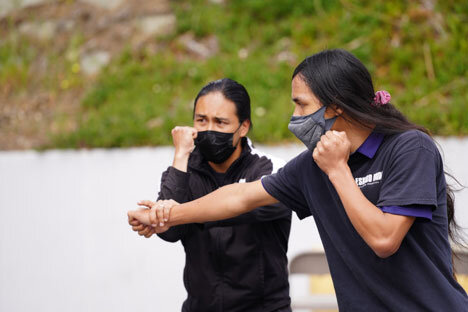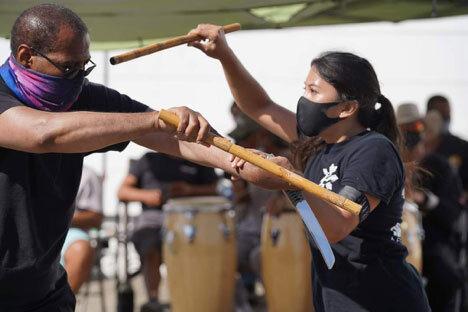Pinoy Self-Defense in the Time of Anti-Asian Hate Crimes
/Bautista (left) says the first line of defense is situational awareness: “Always keep your hands up to defend yourself.”
Getting out of a subway train, the ATM or even church, you never know when an assailant twice your size could be waiting in ambush.
Only in the movies does the victim strike back at the attacker with any success. But this is real life, you say. When danger comes, paralysis sets in and so does any thought of defending yourself.
But if you didn’t already know, Filipino martial arts have been showcased in movies like Fast and Furious, Bourne Identity, John Wick, Jack Reacher, Deadpool, Taken, The Hunted and Arrow (on cable). The list goes on, says Eskabo Daan practitioner Joseph Bautista, who teaches self-defense and first aid.
When you are struck down and fall to the ground: “If the attacker is leaning in with his head, kick the head. If his legs are closer, kick his legs. Always get up as quickly as you can while keeping your distance and your hands up guarding your face while standing.”
If there were a dan ranking system for Eskabo Daan, Bautista would hold a master’s rank. He has been practicing Filipino martial arts for 20 years. He started training in martial arts when he was four (three years earlier than Jet Li and about the same time as Donnie Yen).
It’s so easy to dismiss lethal Filipino martial arts when most moviegoers mostly see the magic of wuxia and the spectacle of Hong Kong wire work. It’s as though many in this generation think that chi only exists in video games and have forgotten Bruce Lee’s practical Jeet kune do.
Bautista says, “Bruce Lee’s Jeet kune do is like Filipino martial arts as it evolves with the times.”
Improvised weapon: “Slap and push away an attacker, then strike with a pen.”
Eskabo Daan says it all: A way of combat that includes Escrima, Serrada Escrima, Kali, Arnis, (Filipino dirty) Boxing and Jeet kune dO.
Bautista says, “Different parts of the Philippines have different types of martial arts. Kind of like adobo from different regions.
“We have ground fighting called Dumog (a grappling technique that is said to be Pinoy wrestling). And we also have the art of eye gouging, pinching, and biting a.k.a Kino Mutai (actually incorporated by Bruce Lee in Jeet kune do as a last resort).
A stick or cane will do: “To deflect an attack, use the abanico strike – a quick powerful flick to the head.”
“In Philippine martial arts, we have a (martial) art that looks like Taekwondo called Sikaran (Filipino martial art that’s over 500 years old). We have what looks like Muay Thai that’s called Yaw Yan (developed in 1970). Aspects of the (martial) art will look like fencing or kendo (Japanese swordsmanship with bamboo sticks). Other aspects can look like Brazilian jiu-jitsu or judo.”
The tale is often told that the Brazilian martial art capoeira evolved as imprisoned slaves practiced their kata (choreographed stances practiced alone) disguised as dance. This is not unique to Brazil.
“An oral tradition of Filipino martial arts is that during the Spanish occupation, it was hidden through dance. Laws forbade the practice of Filipino martial arts and metal weapons were taken away,” Bautista explains.
In a frontal attack, the woman at right “defends herself from getting punched in the face by slapping away the punch and stepping off the attacker’s line of attack.”
“The tinikling is what hid our footwork. Imagine being in the middle of a clock with V-shape movement 10:00 or 2:00. Think of maglalatik (as the equivalent of Ip Man working out with the wooden man) -- actually targeting openings in Spanish armor like the joints of the wrist, elbow, and armpits. The binasuan (dance involving glasses balanced on the head and both hands) is useful for escaping wrist grabs and other locks. (Think of the duel of glasses at the restaurant between Michelle Yeoh and Zhang Jin in Master Z: the Ip Man legacy as binasuan on steroids.)
“When you really watch the moves in these dances knowing this, you can understand how it was hidden in plain sight.”
Lest you think it’s just for dancing, you should know that, like Krav maga, elements of Eskabo Daan are taught to special forces all over the world. And just like Krav maga, the mentality of Eskabo Daan is to end the struggle and win at all costs. There is no poetic waxing over Zen. There is no posturing, only a force of will to quickly defeat a superior force.
And if you envision Jackie Chan’s physical regimen in Drunken Master, you’ll be surprised that Eskabo Daan’s training is a cake walk by comparison.
Follow through: After blocking an attack, the woman defending herself grabs attacker’s arm and attempts to break it
Bautista says, “Filipinos are not the biggest or strongest in the world but we have had 2,000 years of battling each other and others to refine a fighting style that allows us to survive.”
A very practical aspect of Filipino martial arts is that, unlike most martial arts, it trains first in combat with weapons before getting into weaponless training. This is an honest assessment of a real-life battles.
In the case of Eskabo Daan, Bautista says, “We believe anyone should be able to defend themselves regardless of age and fitness level. Although some schools (of martial arts) will spend a lot of time working on cardio and fitness, we don’t put a high emphasis on cardio and being in great physical shape to be able to practice Filipino martial arts. At Eskabo, we do offer fitness and cardio workouts, but it is not necessary to be in tip top shape to defend yourself.
“When you come down to it, as we get older, we won’t be able to sustain cardio and fitness exercises. So, we train with the thought that even when we are in our 80s and 90s we can still defend ourselves.”
Talk about relevance: Eskabo even offers workplace self-defense classes.
Eskabo was voted one of the Best Martial Arts Schools in the San Francisco Bay Guardian’s Best of Bay Reader’s Poll in 2018, in the same category five years in a row in SF Bay Area A-list and Best of the Bay by the editors of the San Francisco Bay Guardian in 2014.
In the end, when you pick a dojo for the toughest self-defense training, know that the board breaking in karate is a Western add-on. Bruce Lee himself said, “Boards don’t fight back.”
For the realistic metrics about the power of the human body, watch the earlier training videos of Manny Pacquiao being beaten by rattan sticks to deaden nerves vulnerable to punches. Muay Thai fighters toughen up by kicking banana trees. In the inner circles of Filipino martial arts, some practitioners bear witness to a number of masters who break coconut shells with a backhand strike, or Sikaran practitioners doing it with their shins. A coconut shell is about as hard as the human skull.
Nothing says Filipino as a coconut shell. You are Filipino and 2,000 years of martial arts is in your history. You can fight back and make a statement against racism.
Harvey Barkin is editor-in-chief at FilAm Star in San Francisco, correspondent for the San Jose Mercury News and content writer for an industry-specific newsletter. He is also a reporting fellow for campaigns and grant-funded projects. Previously, he was a correspondent for news portal BenitoLink, a tech writer for Silicon Valley start-ups and a book reviewer for Small Press in Rhode Island. His work has appeared in various media from advertising copy and collateral to B2B content and in various outlets from Valley Catholic to Inside Kungfu.
More articles from Harvey I. Barkin









